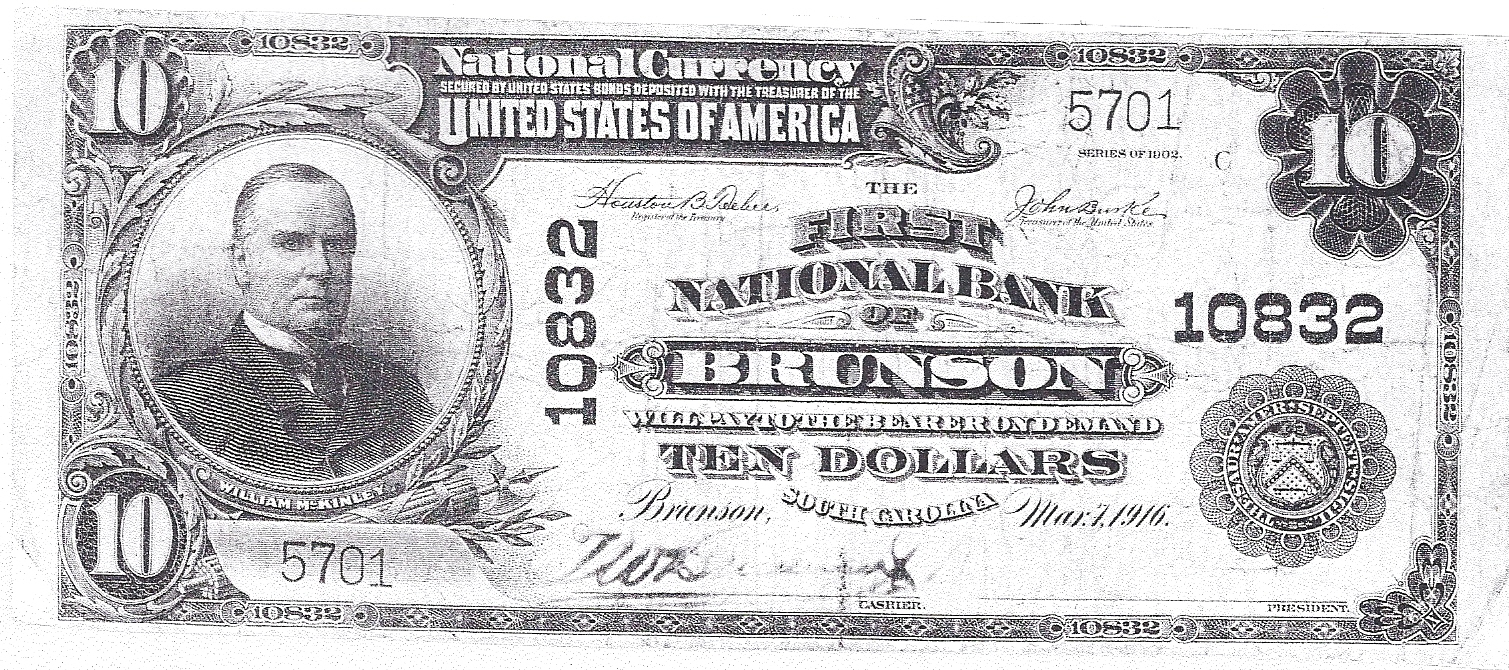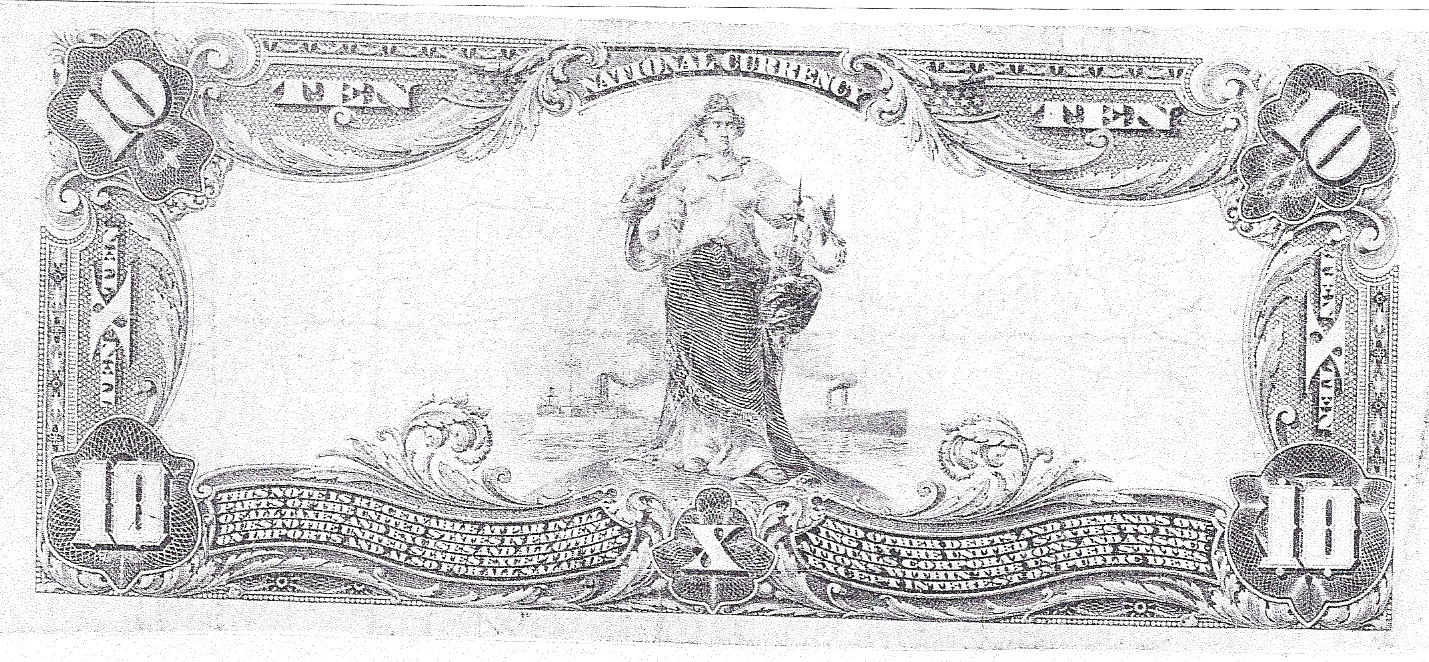The Early Days Before 1872
Roads were few and the individual family lived as a separate unit, depending upon himself and his family for necessities and pleasures. Into this primitive scene one day in the Middle Decade of the nineteenth century came the news that a railroad was to be built from Port Royal, South Carolina on the Atlantic coast, to Augusta Georgia. This was the event that changed things. Until now, large plantations owned by slave-holders occupied this area. Brunson, situated in the Northwestern part of Beaufort District, Prince Williams Parish, was not even a settlement until a few years before the Charleston and Western Carolina Railroad reached this section.
The plantation owner who lived in the backwoods had to go to the Savannah River to get a steamer to Savannah or to wait for his annual shipment of supplies from the city. When news of a railroad came, the families were excited. They would no longer have to go the river for transportation. Instead, the land owners from the river would have to come to the backwoods area to catch a train to the city, and to pick up freight from the railroad. Railroad construction began and had reached Early Branch when the civil war broke out and interrupted its construction. After the war ( about 1875) it reached and passed Pineville which was then the Town of Brunson.
The Pocotaligo Road running from Pocotaligo Station to Augusta was route of travel for stagecoach and private conveyance. The coach stopped regularly at Oakgrove, the Colonial home of James Cameron Richardson, approximately 1 1/2 miles Southwest of the community of Pineville.
Confederate crosses on graves in the Brunson cemetery bear testimony of the many young men who fought in the War for Southern Independence. In early 1865, one of Sherman's outfits camped overnight at Oakgrove. The story goes that Mr.... Richardson gave the commanding officer the Masonic sign asking for protection for himself and his family, and the home was not burned. The three story dwelling still stands today and is on the National Register of Historical Places. From page 273 of Memoirs of General Wm. T. Sherman, we quote: " I camped the night of February 02, 1865 at Duck Branch Post Office, 31 miles from Pocotaligo." If the distance was measured today, it is 31 miles from Pocotaligo to the Richardson home, and even though we do not know the exact spot where Duck Branch Post Office was located, we do know that Duck Branch runs very near the Richardson place, and flows into the Coosawhatchie River.
When these articles of history were written, there was only two descendants of William Edgar Brunson, Sr who live in or near the Town of Brunson. They are Mrs.... Hugh Ester Williams Preacher, a fourth generation descendant, and Hugh T. Lightsey, a fifth generation descendant. In 1963, Marion Brunson of Enterprise, Alabama printed a book on the history of his family, and included information about the Town of Brunson and William Edgar Brunson, Sr. This information was given to him by the late Mrs... Etha Brunson Holladay, a granddaughter of the founder, and the late Mrs... Addie Tuten Lightsey, a great-granddaughter. We quote from his book:
William Brunson, the fourth son born to Isaac and Margaret Brunson, was born in 1723. He married Sarah Elizabeth Frierson. They lived on Black River between Sumter and Darlington and were large property holders. Some of the land transactions of William Brunson are as follows: The Council Journal for 1754, Page 12- William Brunson granted three hundred acres of vacant land on the Santee River, January 05, 1754. Sarah and William had one son, Peter Brunson, born December 28, 1754, and is mentioned in the history of Orangeburg.
William Brunson died January 27, 1796, and little is certain about his widow Sarah and their young son, Peter. It is believed that Peter was the progenitor of the Brunson, South Carolina line of the family. Assuming this is correct, Peter grew maturity around the Santee River, and later moved to the area of what is now Hampton County. Peter Brunson had at least one son and his name is not certain. This son left Beaufort District with his wife and traveled southward in a covered wagon in search of a more desirable place to homestead. They left their two sons, William Edgar and John, with their aunt, Mary Elizabeth Brunson Thames. Several days after leaving on their trip in search of a homestead, a terrible storm struck the Carolina coast and it is believed that they were lost in the storm since nothing was ever heard of them. The two sons were reared by their aunt in Beaufort County (now Hampton) where they lived the remaining years of their lives.
William Edgar Brunson was born August 10, 1811. He married Maria Caroline Mole on February 11, 1838. They settled on land which was homestead by his family. These grants were issued by King George III and are in possession of the family today. It was in honor of William Edgar Brunson that Brunson, South Carolina was named.
William Edgar accumulated some three thousand acres and owned a large number of slaves. He died June 11, 1885, and his wife died March 29, 1902. They are both buried in the Brunson Cemetery which he gave to the town as it was planned in part of the acreage.
To induce the Charleston and Western Carolina Railroad to go through this section of Beaufort County, William Edgar and his brother John gave a right-of-way and ten square acres for a town.
The census records dated September 17, 1850 show William Edgar Brunson living in the Prince William Parish, Beaufort District. He was a planter and he and his wife had four sons and one daughter. The census dated September 18, 1860 shows him getting his mail at Duck Branch Post Office, and at that time, he had five sons and three daughters, and there was a school mistress living in the home by the name of Lucy A. Cocran. The census also shows that he was born in South Carolina, had real estate valued at $28,500, and personal property valued at $25,000. In 1870, census is a very poor record, and this family did not reflect in that year. In 1880, he was shown as living in the village of Brunson, Peeples Township, and only one daughter was left at home, the others reflecting in households of their own in the same vicinity. From the best records available his children were as follows:
Pharius Leroy Frank
James J. Thaddeus Walter
Wiley Wilson Henrietta A. (Richardson)
William E. Lagatsy Caroline (Williams)
Mary R. (Causey) Susan Levenia (Brunson)
THE TOWN AND IT'S GROWTH
The Town of Brunson was chartered in 1874; however, on November 07, 1872, a post office was established in this community. Deeds on record in Hampton County Court House refer to a plat of the town made by R.J. Manker in June 1870.
In the material taken from the cornerstone laid in 1909 at Brunson High School a note was found saying that Henry M. Ulmer was the first intendent of the Town of Brunson. The first Mayor on record in the Town Hall was Major L. F. Huges who was sworn in on October 21, 1885. A picture of all of the Mayors on record can be seen in the Town Hall, except for two- Capt. George W. Brunson and J.R. Langford.
The Brunson Town Hall, once a Robert Ripley syndicated news item, was built in 1906 by J.J. Knopf of Fairfax at a cost of $425.00 for the building and an artesian well- contractor to furnish all materials. Octagon shaped, it stood on stilts until 1959 when it was moved to a new location and taken off of it's stilts. It was built to serve a triple purpose. First purpose was to have a Municipal office and meeting place for Mayor and Councilmen, second was to provide a recreation spot for citizens of the- town, and third was to provide shade for the artesian well. The "Well" was the meeting place with benches provided for townsmen and visitors. While the open arena under the hall was planned for pleasure, it was also used as the town's voting place, and the townspeople will tell you that many a cotton crop was planned there.
The artesian well covered by the stilted Town Hall gave way to a modern water supply installed in 1952. A modern sewer system was installed in late 1978.
The fire bucket brigade was replaced with a shiny red fire engine, and an alert crew of volunteer firemen.
The streets of Brunson are named for families: Addison, Manker, Matthews, Folk (no longer existing) Hanna, Lightsey, Preacher, Nix, Brabham, Floyd, Cone, Brunson, Baggett, Williams, Harvey, Early, and Adams. Some of the other streets include Main, Broad, Railroad Avenue, Mill, and Water.
INVITATION TO LEARNING
In the dim past, on the lands of Pharrius Brunson, stood Pineville Academy the only house on the grounds of the present incorporated Town of Brunson. This log building with clay chimney was the community center where itinerant preachers held meetings. Occasionally one would stay for a few weeks and hold school.
Minutes on file in the Brunson Town Hall show that in 1886 the following were appointed as trustees of the Brunson Graded and Military School: Capt. H. M. Ulmer, Capt. W.P. Hogarth, Maj. J.P. Lovett, Col. B.R. Lewis, and Maj. L.F. Hughes. Autograph books with the date November 19, 1886 bear inscription Brunson Graded and Military School.
Report cards and honor cards dated 1889; the first Annual catalogue for 1891-92; a graduation invitation dated June 1892 and school pictures show that Brunson Graded School was very much a part of the community until about 1905. Resident pupils had free tuition but non-resident pupils were charged the very low rate of $1.00, $1.50, or $2.00 per month. Board could be obtained in private homes for $8.00, $10.00, or $12.50 per month. This school was a wooden two story building at the South end of Manker Street. In the Memoirs of Dr. R. Lee Robinson, he remembers how happy he was when his father took him to Brunson to enter school in January 1892 and he boarded in the home of Prof. W.V. Lanier. In exchange for room and board, he fed and cared for the Professors horse.
Brunson High School was organized about 1905 with students coming from as far away as St. Stevens, Seabrook, Early Branch, and other nearby communities. Some boarded in private homes and some came each day on the C&WC train.
There were few graded schools in the low-country. A catalogue dated in 1907-08 reflects tuition free, night classes $4.00 per month. A two story brick building built in 1908 on three acres of land acquired from John L. Folk was used as a high and elementary school through 1954, and as an elementary school through 1956. The first of it's kind in any small town, the town story brick building was dedicated on March 26, 1909 with the Brunson Lodge No. 167 AFM in charge of dedication. W.D. Barnes was Chairman of the Trustees, and in his speech he said that Governor M.F. Ansel and other prominent people were present for the dedication.
Since 1956 we have continued to have an elementary school, located on the same lot, but in a more up-to-date building. Today the school is integrated and has two hundred or more students in the kindergarten through eighth grade.
The First National Bank of Brunson
In the earlier years, Brunson had its own bank (The First National Bank) as well as its own currency. The photo below was provided to the town to be displayed to show that as a part of its history.

